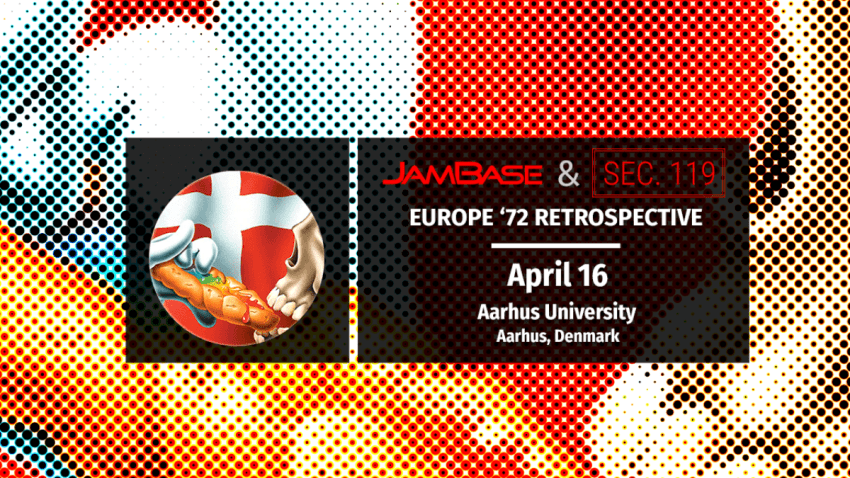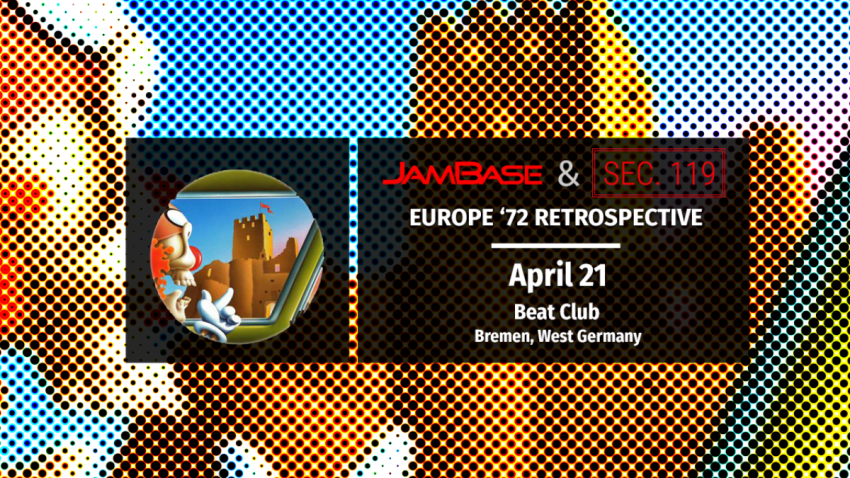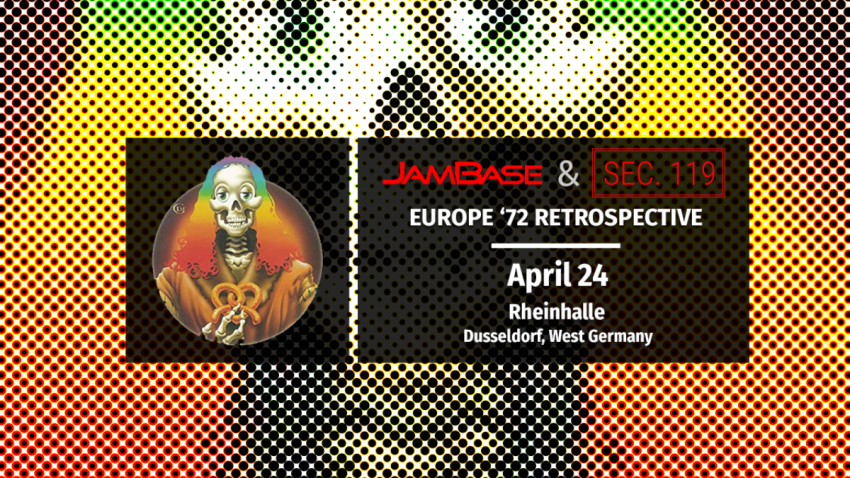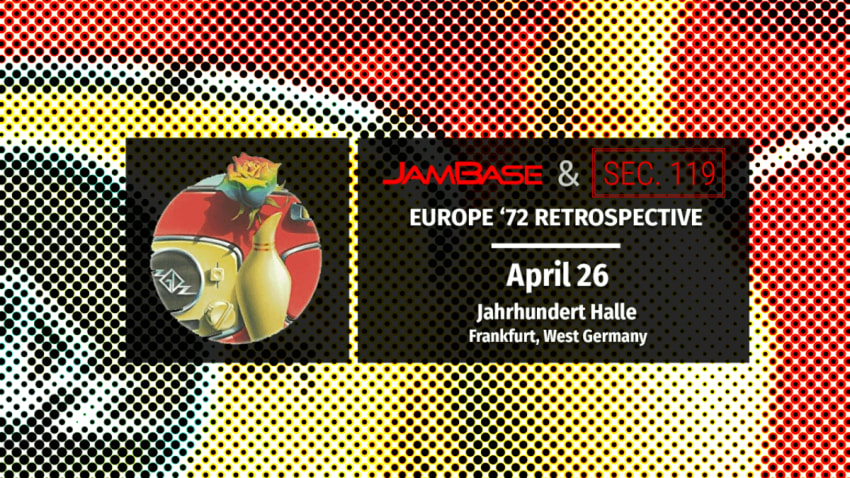Grateful Dead’s Europe ‘72 Tour 50th Anniversary: April 29 – Hamburg, West Germany
Revisit the historic tour’s 10th performance, recorded at Musikhalle.
By Andy Kahn Apr 29, 2022 • 10:16 am PDT
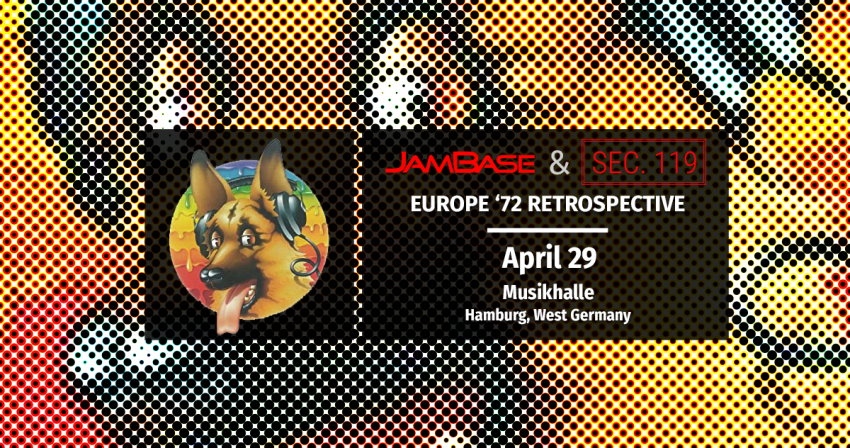
In April 1972, the Grateful Dead embarked on their now-legendary Europe ’72 Tour. The band performed 22 times between April 7 and May 26, resulting in the landmark triple live LP, Europe ’72 that was released in October of that year. To celebrate the legacy of the band’s historic tour abroad, JamBase presents a retrospective look back at each of the Europe 1972 Grateful Dead performances.
The Grateful Dead’s Europe ‘72 Tour made its penultimate stop in West Germany for a performance on Saturday, April 29 in Hamburg. The fourth of five shows in the country occurred after three off days and traveling 497 kilometers north from Frankfurt to Hamburg. Their next show in West Germany would take place on May 18 in Munich.
The two set concert was the tour’s last April show as well as the 10th performance of the 22-date run. Musikhalle, which is currently in operation, later had its name changed to Laeiszhalle. The history of the venue is detailed on its official website, which states:
The Laeiszhalle is a distinguished institution and a wonderful venue for early music, song recitals, chamber music and jazz. When it first opened its doors on 4 June 1908, the Laeiszhalle was Germany’s biggest and most modern concert hall. It’s an important neo-Baroque landmark in Hamburg and a focal point of the city’s musical life …
[Laeiszhalle] has a proud history of guest performances by composers such as Richard Strauss, Sergei Prokofiev, Igor Stravinsky and Paul Hindemith, all of whom conducted their own works here. Audiences also enjoyed epoch-making performances by emerging global stars such as a 12-year-old Yehudi Menuhin and a young Vladimir Horowitz, and later by legends such as Maria Callas.
The concert hall is named after the Hamburg shipowner Carl Heinrich Laeisz (1828–1901). In his will, he decreed that his company F. Laeisz would donate 1.2 million marks to build a “magnificent venue for the performance and enjoyment of fine, serious music.” His widow Sophie Christine Laeisz raised the figure to 2 million marks and, as the developer, conducted the negotiations with the city authorities. The Laeiszhalle was designed in a neo-Baroque style by the architects Martin Haller and Emil Meerwein, who had previously made a name for themselves with the construction of Hamburg City Hall …
[T]he Laeiszhalle Grand Hall remains one of Europe’s best philharmonic concert halls. The Symphoniker Hamburg regularly gives concerts here as the resident orchestra, and a number of other regional orchestras, choirs and promoters use the hall. World-class pianists such as Grigory Sokolov and Martha Argerich, and singers such as Cecilia Bartoli and Jonas Kaufmann have said that they love the hall and its excellent acoustics.
The first of two “Playing In The Band” openers to take place in Europe got the April 29 show off to an unexpected start. Guitarist Bob Weir led his bandmates into the song, eschewing an introduction for vocalist Donna Jean Godchaux that often preceded “Playing” performances on the tour. The relatively tight rendition (running time: 9:48) nonetheless ushered in the first of the show’s several extensive improvised sequences.
Bobby told the German audience “Danke schön” at the conclusion of “Playing.” Guitarist Jerry Garica then led the band through a languid “Sugaree,” setting the tone for an overall laidback feeling that permeated throughout both sets. Weir’s delivery of “Black Throated Wind” was another example of the fairly restrained approach the band took.
Between “Sugaree” and “Black Throated Wind,” Ron “Pigpen” McKern then presented the 10th “Mr. Charlie” of the tour, one of six songs the keyboardist would front during the show.
Weir discussed Pigpen’s role with the band at the time in a Rolling Stone interview with David Fricke from January 2011:
RS: Pigpen sounds strong and determined in his featured numbers. But was it hard to watch his energy and contributions ebbing away during that tour?
Bob Weir: He’d cut his drinking back a whole bunch. What took him down was a congenital situation. We were just beginning to get the drift of that. There wasn’t much anybody could say or do, so we didn’t dwell on it.
[Keyboaridst] Keith [Godchaux] and [his wife, singer] Donna were just finding their way in, finding they had the groove, and that was fresh. I remember on a warm-up gig, on the way to Europe: We had just rocked “Sugar Magnolia”, and there was a pause before we went into the coda. I was about to count off the last bit. I looked over at Keith, and he did a fist pump. He’d got it.
It was a new plateau for him, and thusly for us. We had the players. We had our ducks in a row.
Additional first set improvisation came in the bridge between “China Cat Sunflower” and “I Know You Rider” that featured nifty interplay between Jerry and Keith Godchaux. Other notable aspects of the first set include Weir still handling all of the “Jack Straw” verses as well as Pigpen playing harmonica on “Big Boss Man” and fronting a 16-minute “Good Lovin’.” While somewhat tame compared to earlier Europe ‘72 versions of “Good Lovin’,” the Musikhalle audience got to hear a Pigpen rap that repeated his common “jump in your saddle and ride” motif while Keith danced around the piano keys. “Casey Jones” closed the set, as it would 17 times on the tour.
Cut from the officially released recording of the Musikhalle concert is a bit of Bobby banter. Weir paused to share with the crowd the score of the UEFA Euro 1972 quarter-final soccer match between West Germany and England that was held the same night at Empire Stadium in Wembley, England (near where the Europe ‘72 Tour began).
“Tonight at Wembley Stadium, Germany won, beat England 3 – 1,” Weir said to little reaction. He then attempted to convey the score in German, which was met with cheers and a smattering of applause.
Weir did introduce the audience to Donna before the start of the second set, which opened with “Greatest Story Ever Told,” marking the first of three times it filled the set two opener slot on the tour. Weir, Garica and bassist Phil Lesh addressed the crowd after “Greatest Story Ever Told,” prompted by Lesh’s commentary on bringing dogs to the show. Garcia also explains the show is being recorded for what would become the Europe ‘72 live album.
Here’s how author and JamBase contributor Steve Silberman captured the exchange in the liner notes for the official release of the April 29, 1972 show:
Phil: “Say, I noticed you bring dogs to concerts here too. Very nice.”
Bob: “Be sure and get your Grateful Dead watches in the lobby.”
Jerry: “We’ll get around to that kind of stuff, don’t worry, everything’s gonna be all right, you betcha! See, we’re making a record, this is a record, this is all gonna be a record someday, so we’re doing songs that a lot of people have never heard before. You know how it is, you can’t do the same stuff forever–not even us.”
Bob: “You end up going colorblind.”
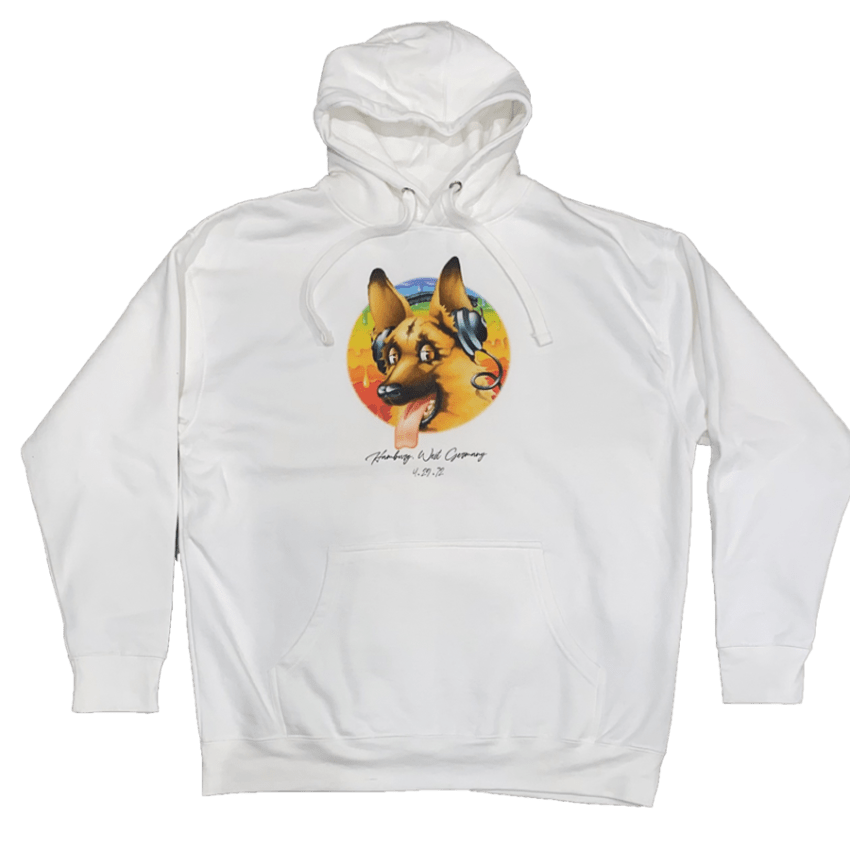
Limited Edition Hoodies

Get your Hamburg, West Germany 4/29/72 Limited Edition Hoodie from Sec.119
Garcia was referring to the ensuing fourth offering of his and lyricist Robert Hunter’s “He’s Gone,” which debuted on April 17, 1972. While still evolving into its final form, this time the “Goin’ where the wind don’t blow so strange / Maybe off on some high cold mountain chain / Lost one round but the price wasn’t anything / A knife in the back and more of the same” segment was added for the first time.
Silberman’s liner notes point to the Pigpen-led rendition of “Next Time You See Me,” as one of the “unheralded gems” of the Europe ‘72: The Complete Recordings box set. Carrying over the vibe from the first set, the harmonica-injected tune was played at a noticeably slower tempo then other versions on the tour.
The rest of the second set consisted of a 30-minute “Dark Star” which segued into “Sugar Magnolia” (as it would seven times in Europe) and finally “Caution (Do Not Step On Tracks).” This was the third such occurrence of “Dark Star” into “Sugar Magnolia” in “Caution” of the tour, which would be repeated once more.
Early in the “Dark Star” improvisation, Lesh initiates the “Feeling Groovy” jam that prominently takes hold around the 6:40-minute mark. The band then shifts to a space sequence of minimalist playing and dramatic fills from drummer Bill Kreutzmann, who eventually lands on a rhythm that is picked up and followed by his bandmates, leading back to the “Dark Star” theme and Garcia laying out the first verse around the 15-minute mark. The back half of “Dark Star” delves back into the unstructured spaciness heard near the song’s onset, finds traction and form and galvanizes around Garcia’s fierce playing. Another of the tour’s impressive segues into “Sugar Magnolia” punctuated the “Dark Star.”
A contemporary review of the April 29, 1972, Grateful Dead concert was written by Franz Schöler. The review appeared in the May 5, 1972, edition of the weekly German newspaper Die Zeit, which read in part, (via deadsources, translated from German):
The Grateful Dead again had their most spectacular success with “Dark Star”, a composition lasting more than thirty minutes that touched the limits of atonal improvisation. Like most of the group, this piece constantly gains new musical aspects on stage. Just as the Grateful Dead spontaneously determine every concert from the moment, so spontaneously tension and musical communication between the band members develop again and again with the individual numbers.
What’s particularly interesting about pieces like “Dark Star” is that they don’t fall into the trap of merely naturalistic sound imitations or arbitrary sound impressionism. Effects don’t play a role like they do with Pink Floyd. Melodic themes intensify and then dissolve again in a constant flow, they change from rock to a strongly jazz-influenced playing style (perhaps drummer Bill Kreutzmann plays the most important role). There are almost no solo spots, the group is a lesson in making music collectively. This form of experimental rock music has nothing to do with the “acid rock” cliché, even if the long tracks of the Dead were mentioned as typical examples.
The constant change of styles is also striking. Growing up on different eras of American popular music, the members of the Grateful Dead have a wide range of tastes that feed through into the band’s music. Organist Ron “Pigpen” McKernan and rhythm guitarist Bob Weir represent the boogie and rock ‘n’ roll faction within the group, while bass guitarist Phil Lesh’s first love was jazz. Jerry Garcia embodies a bit of the country music trend in the band. Phenomenal virtuosos are drummer Bill Kreutzmann and the newly added pianist Keith Godcheaux, who masters all styles ingeniously. From a country number, the group moves effortlessly into a rhythm and blues song, and a lengthy improvised track is followed seamlessly by a hard rock composition such as”Big Boss Man”. One can really only appreciate such versatility by listening.
Almost all rock bands have a member who represents the engine, the musical soul of the group – such as guitarist Keith Richard in the Rolling Stones. The Grateful Dead’s music, on the other hand, lives from the awareness that all members are equally important, and this is what makes the “grateful dead” so alive and a completely integrated ensemble in which there are no ego trips. One of the few comparable counterparts that comes to mind is the folk-rock group The Band, which in its own way also works through the history of American pop music and, because of its stylistic versatility, is one of the most progressive – in the right sense.
With such bands, the difficult balance is endangered time and time again, and no two concerts are the same. The Grateful Dead didn’t play as well at their concert in Frankfurt as they did at their triumphant guest performance in Hamburg. But that also characterizes such a difficult group, which musically recreates its spirituality at every concert.
The encore was the first and only on the tour to have two songs. First up was a Saturday night offering “One More Saturday Night.” That was trailed by the tour debut of “Uncle John’s Band,” which would appear in four additional Europe ‘72 setlists. None of the songs played at Musikhalle were selected for Europe ‘72.
View a six-second, silent clip, believed to be recorded at the April 29, 1972 show at Musikhalle:
Here are additional statistics and information regarding the 10th performance of the Grateful Dead’s Europe ’72 tour:
At-a-Glance
The Show |
|
|---|---|
|
April 29, 1972 |
|
|
8 p.m. |
|
|
DM 10 |
|
|
2,025 |
|
|
308 |
|
The Music |
|
|
14 songs / 87 minutes |
|
|
8 songs / 89 minutes |
|
|
22 Songs / 176 minutes |
|
|
Dark Star 30:11 |
|
|
Chinatown Shuffle 2:47 |
|
|
9:43 |
|
|
9 Jerry / 7 Bobby / 6 Pigpen |
|
|
48 |
|
Setlist (via JerryBase)
Set One: Playing In The Band, Sugaree, Mr. Charlie, Black Throated Wind, China Cat Sunflower > I Know You Rider, Big Boss Man, Jack Straw, Loser, Chinatown Shuffle, Me And My Uncle, Big Railroad Blues, Good Lovin’, Casey Jones
Set Two: Greatest Story Ever Told, He’s Gone, Next Time You See Me, Dark Star [1] > Sugar Magnolia > Caution
Encore: One More Saturday Night, Uncle John’s Band
Notes:
- [1] Includes Feelin’ Groovy Jam
Below, stream the official recording of the Grateful Dead’s April 29, 1972 concert at Musikhalle in Hamburg, West Germany or check out other recordings via Archive.org:
-

Grateful Dead’s Europe ‘72 Tour 50th Anniversary: April 16 – Aarhus, Denmark
-

Grateful Dead’s Europe ‘72 Tour 50th Anniversary: April 17 – Copenhagen, Denmark
-

Grateful Dead’s Europe ‘72 Tour 50th Anniversary: April 21 – Bremen, West Germany
-

Grateful Dead’s Europe ‘72 Tour 50th Anniversary: April 24 – Dusseldorf, West Germany
-

Grateful Dead’s Europe ‘72 Tour 50th Anniversary: April 26 – Frankfurt, West Germany
